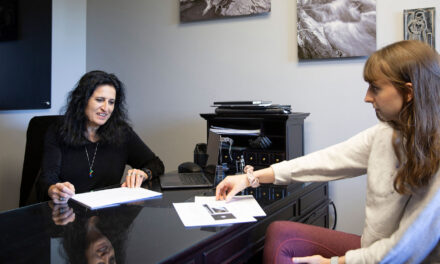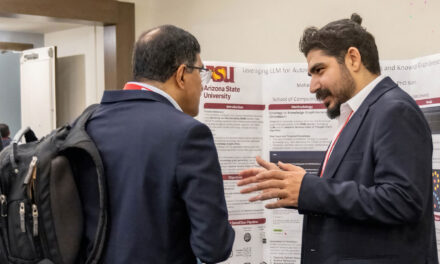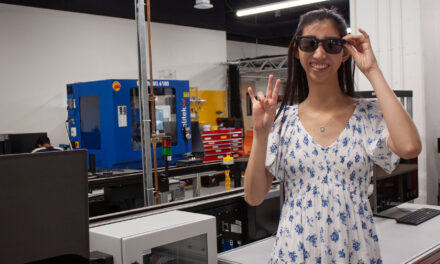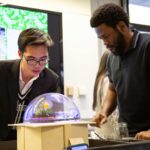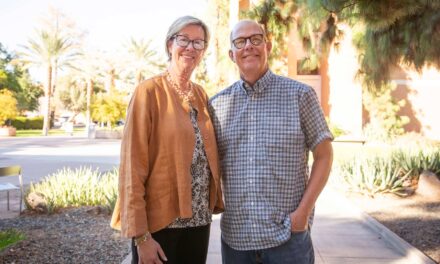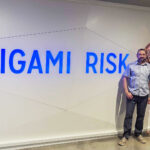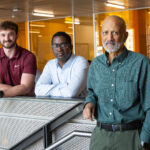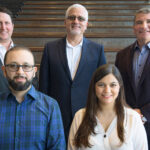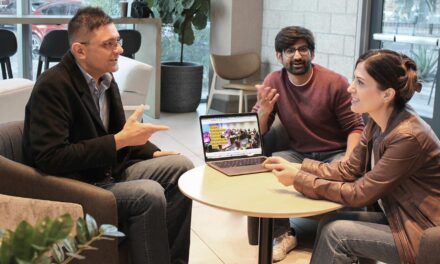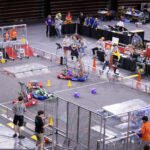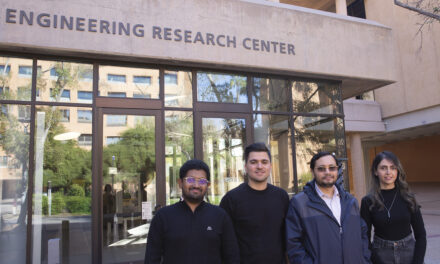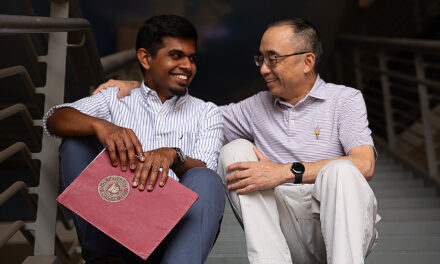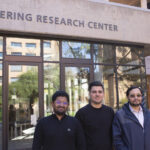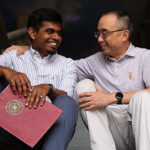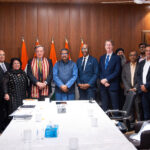
ASU researcher makes quantum leaps in materials engineering
Presidential award recognizes Fulton Schools professor’s promising research contributions to technological progress
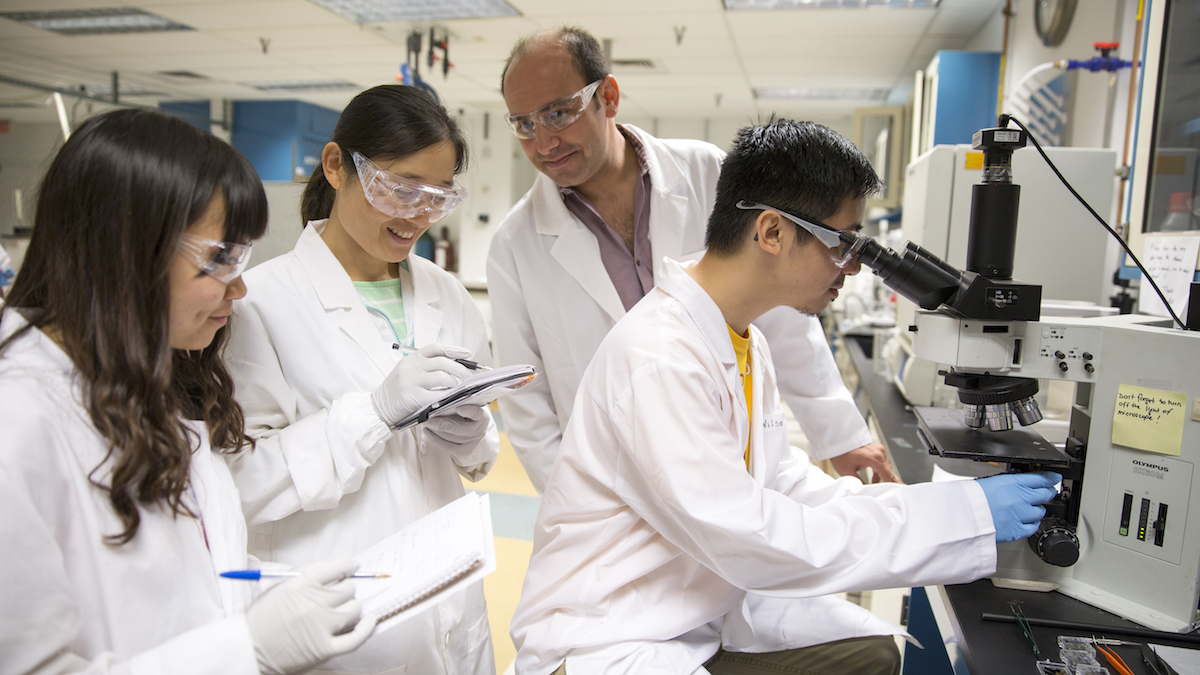
Above: Sefaattin Tongay (second from right), an Arizona State University associate professor of materials science and engineering, consults with students in his lab who are assisting in his research on 2D materials. Promising progress Tongay and his research group are making in the use of those materials to achieve significant technological advances has earned him a prestigious Presidential Early Career Award for Scientists and Engineers from the U.S. government. Photographer: Jessica Hochreiter/ASU
Classic 3D materials that have enabled some of our most impressive technological progress can’t meet the demands necessary to rise to the next level of advancement, Sefaattin Tongay says.
Tongay, an associate professor of materials science and engineering at Arizona State University, calls silicon a “great” material but with limited ability to produce significant improvements in devices beyond transistors and solar cells. Cadmium mercury telluride is another good material to work with, he says, but for not a whole lot other than developing better infrared detectors.
But when those and other versatile materials can be confined in two dimensions — something Tongay does in his work — new properties and capabilities emerge that open possibilities for using 2D materials to not only improve existing technologies but to create new ones with an array of productive uses.
These crystalline materials consisting of only single layers of atoms are poised to be essential elements driving dramatic progress in computing, communications, information security, energy generation, light-emitting devices and much more, says Tongay. He has been conducting research on 2D materials for almost two decades, and since 2014 when he joined the School for Engineering of Matter, Transport and Energy, one of the six Ira A. Fulton Schools of Engineering.
Tongay’s contributions to the field recently earned him a Presidential Early Career Award for Scientists and Engineers.
Called PECASE awards, they are described as the highest honor bestowed by the U.S. government on outstanding scientists and engineers who are showing exceptional promise for leadership in their fields.
Tongay’s work in materials at ASU has included five research projects supported by the National Science Foundation — including one that earned the prestigious NSF Faculty Early Career Development (CAREER) Award to fund a five-year, $500,000 research project focusing on 2D materials systems.
The U.S. Department of Defense and a semiconductor industry company have also funded Tongay’s work.
Three of the larger projects have funding through the next two years. By that time, the Tongay research group expects to have expanded understandings of the optical, electrical, mechanical and magnetic properties of 2D materials enough to use them to help open a path to new applications in myriad technologies.
The big step in fully utilizing these materials lies in unleashing their ability to push technologies into the realm where the power of quantum physics can expand the horizons of our technological capabilities.
“Our current technologies work by using electrons as communications carriers. Basically, all of our technology is based on electricity, and there is only so much you can do by relying on that,” Tongay says.
Using quantum bits — the smallest quantities of radiant energy — instead of electrons could launch a plethora of new possibilities beyond the reach of conventional electronics.
Quantum technology uses electromagnetic waves, photons (energy-carrying particles representing a quantum of light) and electron spin (a quantum property of electrons) as the sparks to energize devices and systems.
Beyond boosting resiliency and reliability, new generation of quantum devices and systems are designed to operate much faster than current versions while enabling completely new functionalities.
“That is the big advantage of what quantum does,” Tongay says. “We are not talking about something like 10 times faster. We are talking about a million or even billions of times faster. We are talking about new functionalities and technologies.”
That high-speed performance would have significant implications for quantum computing and quantum information processing. But 2D materials can also play critical roles in advances in quantum emitters for use in quantum communications technologies and quantum cryptology devices for cybersecurity and information protection, Tongay says.
His research has in recent years been revealing significantly more evidence about what quantum-grade 2D materials can do to contribute such innovation.
Achieving the goal will involve perfecting what 2D crystalline materials can accomplish through their imperfections.
For Tongay’s purposes, perfect materials are ineffectual. For example, silicon without imperfections “is useless,” he says. But with the right kind of imperfections, they become semiconductors that can power devices.
Perfect metals, for instance, “are brittle” and thus of little use. “But when you introduce certain defects they become softer, which makes them stronger and safer, so then they are useful,” he says.
Tongay’s research team’s focus is on discovering what defects will enable the most valuable capabilities and then creating those defects to engineer useful functions. In doing so, the team is learning more about the fundamental physics of 2D materials defects and how the materials and their defects can provide building blocks for quantum technologies.
A related goal is to develop techniques for scaling up the manufacturing of such useful defects in materials.
In addition to pursuing new technological advancements, the contributions recognized by the PECASE Award also include Tongay’s work aligning with a key aspect of the NSF’s mission: educating the next generation of materials science and engineering experts.
Currently, Tongay is giving six doctoral students, two master’s students and four undergraduate students opportunities for valuable research experience in his lab.
The students also benefit from the lab team’s collaborations with other research teams in the United States and other countries — some led by prominent experts in their fields, including Professor Feng Wang at the University of California, Berkeley, Professor Christian Schneider at the University of Würzburg and Professors Mete Atature and Andrea Ferrari at the University of Cambridge.
Tongay’s education outreach efforts include providing introductions to the research environment for young students from communities that are underrepresented in science and engineering.
His lab’s “summer school” sessions bring several high school students to ASU’s Tempe campus to participate in projects. Four of those students from years past have gone on to earn doctoral degrees. Several others have earned master’s or undergraduate degrees.
Tongay says all of them are now doing research at universities or in industry.



